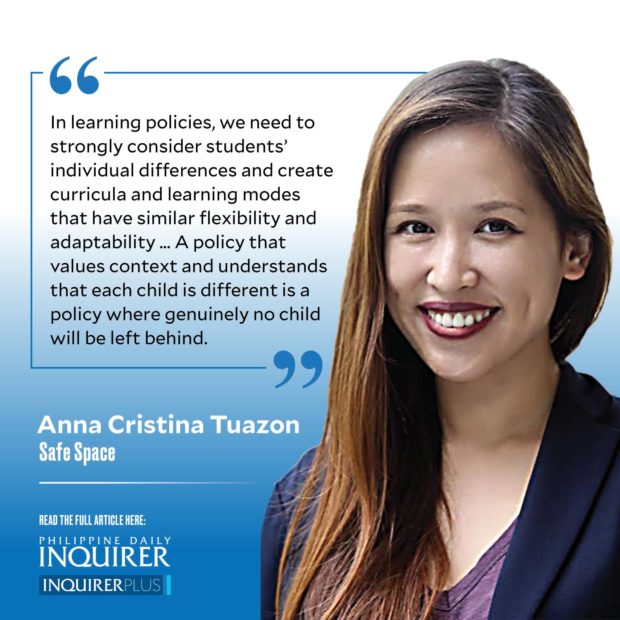One size does not fit all
It seems like 2022 is the year of reprioritizing education. The Department of Education has announced that they will require a 100 percent return to face-to-face classes starting in November. The Asian Development Bank (ADB) also released its recommendations, urging the Philippines to extend its class hours and shorten vacation days as a way for students to catch up on the learning that was lost in the past two years. I must admit that I have mixed emotions about this. I have expressed numerous times about the inadequacies (and inequities) of remote learning currently implemented by our public school system. I also previously shared my concerns about children being kept at home, and the severe lack of proper socialization stunts their socioemotional development. The return to face-to-face classes should be a welcome direction. So why am I uneasy?
My unease stems from the absoluteness of the mandate, which requires in-person attendance and forcing all schools, regardless of their circumstances and resources, to return to 100 percent face-to-face in a matter of months. This despite calls from teacher’s groups to allow them to continue to offer hybrid formats as they balance social distancing requirements and accommodate students and their families’ preferences. Some families still do not feel safe sending their children to school and risk bringing the virus into their households. In my experience working with school-aged children during this pandemic, some thrived with online classes, while others went as far as to take a leave of absence to wait for the return to face-to-face instruction. I can tell which of my clients will do better in a classroom and which ones will benefit from continued remote learning. The lesson here is that not everyone learns the same way. The problem with one-size-fits-all policies, especially in education, is that they don’t consider individual differences and will poorly serve a significant number of students. The ADB recommendations are well-meaning but also fall into the pitfalls of one-size-fits-all. Their suggestions don’t consider that students’ capacity and thresholds for focus and attention had been severely reduced during the pandemic. Simply requiring them to study longer will invoke more psychosocial problems and less motivation to learn, which will lead to higher probability of dropping out altogether.
When I taught introduction to statistics to college students, I would tell them about Todd Rose’s “Myth of the Average.” When you’re designing for the average person, you are essentially designing for no one. This is simply because no person is average in every single way and, as such, you are designing for a person that does not exist. A classic example would be the case of car seats. If one designs a car seat that would fit the person with the average height, relatively tall people wouldn’t be able to get in and relatively short people would have a hard time seeing over the wheel. Instead, it is better to accommodate individual differences in one’s design. In this example, the solution led to adjustment levers on a car seat.
Disaster mental health is another excellent example where one-size-fits-all policies will not work. A comprehensive and effective mental health and psychosocial support program require a tiered approach to our services instead of a singular service applied to all. For example, we have cautioned companies and local government units on requiring debriefing for all survivors and responders, noting that this can actually be harmful to some. Instead, creating a range of services and supports, from the community and lay people to professionals and experts, makes up an effective mental health program since it can accommodate a much more comprehensive range of concerns and issues.
In learning policies, we must strongly consider students’ individual differences and create curricula and learning modes with similar flexibility and adaptability. In the pandemic context, we must design learning formats that can adapt to different pandemic alert levels. One big issue I have with devoting all energies toward face-to-face instruction is that in the event of an outbreak among the students, which will require a temporary return to remote learning, schools and teachers are left unprepared yet again for such a transition. The hybrid model seems to offer the best flexibility, maintaining infrastructures for remote learning that will allow for much less stressful transitions while taking advantage of in-person learning during safer times. We should also strongly advocate that curricula be accommodative of students’ context. Imagine a curriculum that accommodates students’ financial limitations, their neurodevelopmental strengths and challenges, and their family’s capacity to actively support their children’s learning. A policy that values context and understands that each child is different is a policy where no child will be left behind genuinely.
——————
aatuazon@up.edu.ph





















